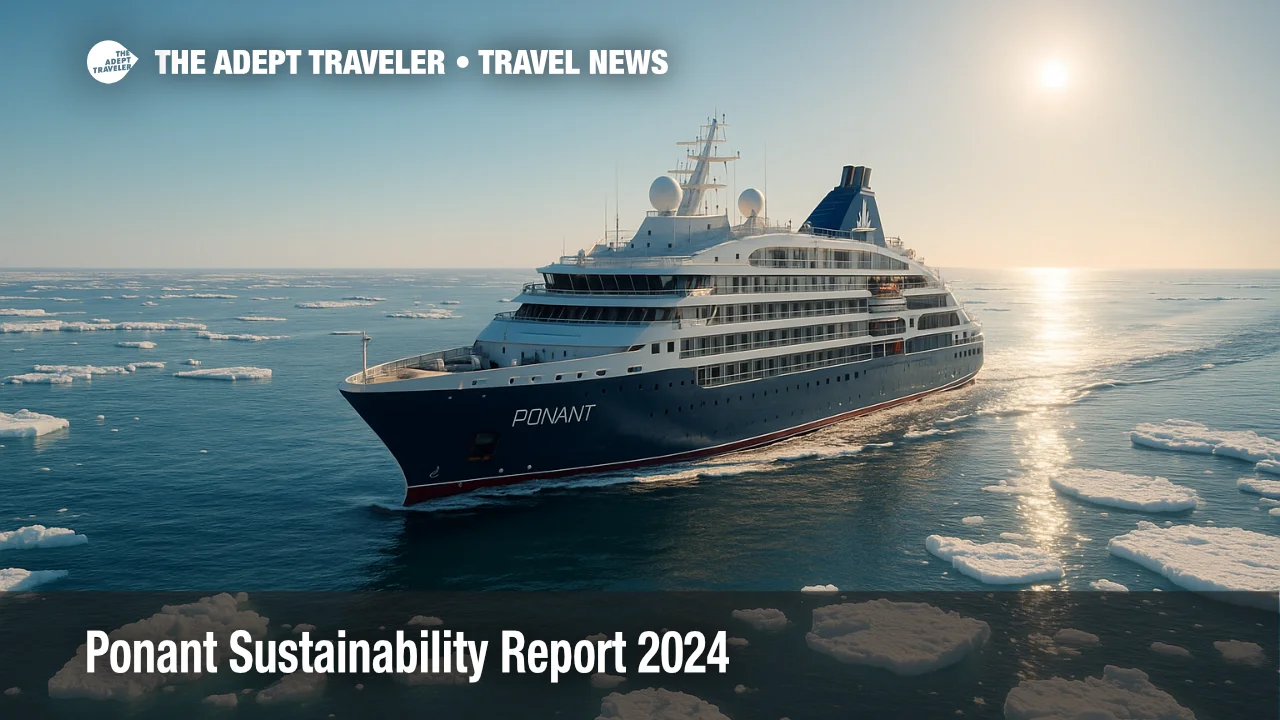Ponant sustainability report 2024 underscores Blue Horizon gains

Key points
- Ponant sustainability report 2024 shows a 14% CO₂ reduction.
- EU Innovation Fund backs Swap2Zero zero-emission ship R&D.
- Programs support Inuit logistics and Polynesian medical care.
- Single-use plastics eliminated and onboard waste sorted.
- Net Zero by 2050 goal guides fleet design and operations.
Ponant Explorations Group has released its 2024 sustainability report, summarizing measurable progress under its Blue Horizon strategy and laying out what comes next. The company reports CO₂ emissions per cruise day were 14 percent lower than in 2018, nearly halfway to its 2030 target of a 30 percent reduction. Backed by the European Union's Innovation Fund, the Swap2Zero research program advances a next-generation, near-zero-emission vessel concept. The report also details waste reductions and programs that support communities in Greenland and French Polynesia.
Ponant sustainability report 2024, what travelers should know
Ponant positions Blue Horizon as an enterprise-wide plan focused on decarbonization, circular resource use, science partnerships, and positive local impact. The 14 percent emissions reduction since 2018 is attributed to continuous improvements in fleet energy efficiency and the integration of alternative energies. The company maintains a 2030 target of a 30 percent cut in greenhouse gases and a longer-term objective of Net Zero by 2050, aligning new ship research and retrofits with those goals. Swap2Zero, co-funded through the EU Innovation Fund that is financed by Emissions Trading System revenues, is the marquee R&D track aimed at a transoceanic ship designed to operate with a vastly smaller carbon footprint.
Beyond fuel and propulsion, Ponant reports that eliminating single-use plastics on board is now fully operational, which it estimates avoided 20 tons of plastic in one year. The line says it sorts 100 percent of shipboard waste and is working port-by-port to raise recovery rates to 50 percent by 2026. Expanded potable water systems reduce packaged water use, while crew procedures and guest communications are designed to shrink daily consumption.
Ponant also frames sustainability as community partnership. In Greenland, the ice-capable Le Commandant Charcot has supported logistics to shorten winter isolation for Inuit communities when regular supply vessels are constrained by sea ice. In French Polynesia, the m/s Paul Gauguin partners with health authorities to offer no-cost consultations and care in remote archipelagos, including the Marquesas, with a plan to scale recurring medical visits.
Analysis
For travelers, the headline is momentum with specifics rather than pledges alone. A verified 14 percent emissions reduction since 2018 indicates real-world operational gains that should compound as new tech arrives. If Swap2Zero's multi-energy architecture reaches service, it could materially lower lifecycle emissions on certain itineraries, especially at slow-to-moderate speeds where wind assistance and hybrid fuel-cell systems shine. Community programs in Greenland and Polynesia suggest sailings that are coordinated with local needs, which can reduce friction at sensitive destinations and add purpose to expedition experiences. The near-term traveler takeaway is to look closely at ship assignment, waste and water practices, and science or community components listed in an itinerary, then choose voyages and cabins that align with those features.
Final thoughts
The Ponant sustainability report 2024 points to steady decarbonization, verifiable waste reductions, and concrete community partnerships. For expedition travelers who weigh environmental performance alongside comfort and access, Blue Horizon's progress and the Swap2Zero pathway provide a clearer basis for choosing routes and ships, today and as the fleet evolves toward Net Zero.
Sources
- PONANT gets European Commission grant for its Swap2Zero project, PONANT PDF
- Objective, zero impact on navigation for PONANT's 14th ship, PONANT
- Our commitments for a more sustainable tourism, PONANT
- Ponant Explorations Group releases 2024 Sustainability Report, Cruise Industry News
- Innovation Fund projects overview, European Commission
- Ponant's 2024 sustainability report coverage, TravelPulse
- PONANT 2024 Sustainability Report, hosted on Calaméo
- Paul Gauguin healthcare partnership details, Paul Gauguin Cruises
